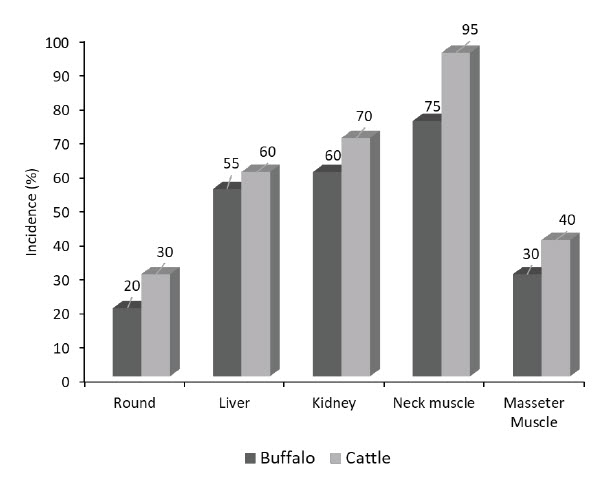Mold contamination of buffalo and cattle meat and offal: A comparative study
Keywords:
Bubalus bubalis, buffaloes, cattle, edible offal, moldAbstract
Bovine (buffalo and cattle) meat and edible offal are considered as essential sources of the red meat worldwide. This study aimed at investigation of the mold contamination of the buffalo and cattle meat (round), and their edible offal including neck muscles, masseter muscles, liver, and kidney in a comparative way. Identification of the prevalent mold genera was followed. Besides, identification of the Aspergillus spp. to the species level was also conducted. The obtained results revealed higher mold contamination of the cattle samples compared with the buffaloes. In both species, neck muscles had the highest contamination rates, followed by kidney, liver, masseter muscles, and round, respectively. Aspergillus spp. was the most prevalent mold genera in all examined samples. Aspergillus niger (A. niger), A. flavus, A. fumigatus. A. ochraceous, A. parasiticus, and A. terreus were the identified Aspergilli. In conclusion, this study demonstrates isolation and identification of different molds from the retailed buffalo and cattle meat and edible offal. Therefore, strict hygienic measures should be adopted during all steps of preparation of such valuable protein sources.
Downloads
Metrics
References
Cockrill, W.R. 1981. The water buffalo: A review. Brit. Vet. J., 137(1): 8-16. DOI: 10.1016/s0007-1935(17)31782-7
Cruz-Monterrosa, R., D. Mota-Rojas, E. Ramirez-Bribiesca, P. Mora-Medina and I. Guerrero-Legarreta. 2020. Scientific findings on the quality of river buffalo meat and prospects for future studies. Journal of Buffalo Science, 9: 170-180.
Darwish, W.S., Y. Ikenaka, S.M. Nakayama and M. Ishizuka. 2014. An overview on mycotoxin contamination of foods in Africa. J. Vet. Med. Sci., 76(6): 789-797. DOI: 10.1292/jvms.13-0563
Darwish, W., R.M. Bayomi, A.M. El-Moaty and T.M. Gad. 2016. Mould contamination and aflatoxin residues in frozen chicken meat-cuts and giblets. Jpn. J. Vet. Res., 64 (Suppl. 2): S167-S171.
Habashy, A.H.A., W.S. Darwish, M.A. Hussein and W.M.S. El-Dien. 2019. Prevalence of different mould genera in meat and meat products with some reduction trials using essential oils. Advances in Animal and Veterinary Sciences, 7(s2): 79-85. DOI: 10.17582/journal.aavs/2019/7.s2.79.85
Ismail, M.A. and Z.M. Zaky. 1999. Evaluation of the mycological status of luncheon meat with special reference to aflatoxigenic moulds and aflatoxin residues. Mycopathologia, 146(3): 147-154. DOI: 10.1023/a:1007086930216
Mizakova, A., M. Pipova and P. Turek. 2002. The occurrence of moulds in fermented raw meat products. Czech J. Food Sci., 20(3): 89-94. DOI: 10.17221/3516-CJFS
Murray, M.G. and W.F. Thompson. 1980. Rapid isolation of high molecular weight plant DNA. Nucleic Acids Res., 8(19): 4321-4325. DOI: 10.1093/nar/8.19.4321
Nasser, L.A. 2015. Molecular identification of isolated fungi, microbial and heavy metal contamination of canned meat products sold in Riyadh, Saudi Arabia. Saudi J. Biol. Sci., 22(5): 513-520. DOI: 10.1016/j.sjbs.2014.08.003
Pacin, A.M., H.H.L. Gonzalez, M. Etcheverry, S.L. Resnik, L. Vivas and S. Espin. 2003. Fungi associated with food and feed commodities from Ecuador. Mycopathologia, 156(2): 87-92. DOI: 10.1023/a:1022941304447
Pereira, J.A., L. Dionísio, L. Patarata and T.J. Matos. 2015. Effect of packaging technology on microbiological and sensory quality of a cooked blood sausage, Morcela de Arroz, from Monchique region of Portugal. Meat Sci., 101: 33-41. DOI: 10.1016/j.meatsci.2014.09.147
Pitt, J.I. and A.D. Hocking. 2009. Fungi and Food Spoilage, 3rd ed. Published by Blackie Academic and Professional Academic Press New York, London, UK.
Preiato, D. 2020. All You Need to Know about Bison Meat. Available on: https://www.healthline.com/nutrition/bison-meat-nutrition.
Tang, H., W.S. Darwish, W.R. El-Ghareeb, N.A. Al-Humam, L. Chen, R.M. Zhong, Z.J. Xiao and J.K. Ma. 2020. Microbial quality and formation of biogenic amines in the meat and edible offal of Camelus dromedaries with a protection trial using gingerol and nisin. Food Science and Nutrition, 8(4): 2094-2101. DOI: 10.1002/fsn3.1503
Tawakkol, W. and N.I. Khafaga. 2007. Fungal contamination of meat and its environment with special reference to the strains producing aflatoxins, ochratoxins, proteinase and lipase enzymes. New Egyptian Journal of Microbiology, 17: 1-14. DOI: 10.4314/nejmi.v17i1.40310
Tegegne, H.A., A. Berhanu, Y. Getachew, B. Serda, D. Nölkes, S. Tilahun and B. Sibhat. 2019. Microbiological safety and hygienic quality of camel meat at abattoir and retail houses in Jigjiga city, Ethiopia. J. Infect. Dev. Countr., 13(3): 188-194. DOI: 10.3855/jidc.9686
Vanderzant, C. and D. Splittstroesser. 2001. Compendium of Methods for the Microbiological Examination of Foods, 4th ed. American Public Health Association, Washington, DC, USA.
Varnam, A.H. and J.P. Sutherland. 1995. Meat and meat products: Technology, chemistry and microbial, 1st ed. Champman and Hall, London, UK.
White, T.J., T. Burns, S. Lee and J. Taylor. 1990. Amplification and Direct Sequencing of Fungal Ribosomal RNA Genes for Phylogenetics. Academic Press, New York, USA.





.png)








